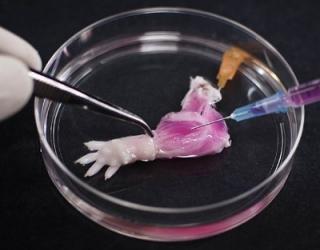World’s First Lab-Grown Biolimb Raises Hopes of Replication in Humans

In a revolutionary research study, surgeons from the Massachusetts General Hospital have devised the first-ever lab-grown biolimb, raising hopes that a similar process can one day offer powerful replacements for human limbs as well.
The research published in the August issue of the journal Biomaterials, was conducted by Harald Ott and his team at the MGH. The researchers have to their credit a tiny pink rat leg, which they have created in the lab via a process known as decellularization.
The technique consisted of removing living cells from the limbs of dead rats. This exposed their scaffolds, the structure that formed the base of further research. Next, the surgeons planted the removed cells that made up blood vessels and muscles onto the scaffolds, in a process known as recellularizotion. Then the structure was left to grow for about two weeks, in a specially designed bioreactor. Henceforth, the surgeons grafted some skin onto the leg.
What they got was a living, fully functional, bioleg that responded to stimuli and even circulated blood, when attached to the animal.
This can be seen as a giant leap in artificial limbs' research as earlier organs that have been created in the lab using decel/recel transplants, have had very few types of cells. The present biolimb, comprised of muscle, blood vessels, skin and bones and was expected to perform a range of intricate tasks. Thus, it was much more difficult to be replicated.
The present research also raises hopes of creating lab-grown human limbs in near future.
You May Also Like
- World’s First Lab-Grown Biolimb developed
- Earlier Unknown Direct link between Brain and Immune System discovered
- A First: Primitive Sperm and Eggs Created from Human Skin Cells
- Sexual Switch in Germ Cells is Independent of Gender, claims Research
- New Fabrication Technique can Create Complex 3D Micro and Nano Structures: Researchers



